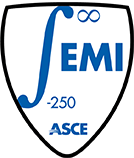From Green’s Functions to Vibration of Nanotechnology Facilities
University of Campinas
Problems
Soil-Structure Interaction problems play a key role in the response in many structures and machinery, including nanotechnology facilities. Seismic activities in the southern part of Brazil are of minor importance and the issue of dynamic soil structure interaction analysis is concentrated in the response of the systems being impinged by waves created due to traffic conditions or due to existing neighboring industrial facilities. A second vibration source is the equipment installed on the foundation itself. Brazil is building a third generation synchrotron light source at Brazilian National Synchrotron Light Laboratory -LNLS near the University of Campinas. The limitations in the vibration of the supporting ring foundation for the synchrotron light beam are very strict and must conform the NIST A criteria. The research group is working in helping to develop engineering solutions for foundation of the lab, which will achieve the vibration environmental requirements set by the research community. The activities of the research group range from the development of simulation tools, the on-site validation and calibration of the numerical scheme up to helping propose engineering solutions to the foundations for the light beam source, surrounding buildings and equipment.
Approach
The group has been working on an integrated approach to analyze the vibration response and vibration mitigation strategies for nanotechnology facilities. The activities include the theoretical formulation and numerical synthesis of Green's functions (GFs) for viscoelastic, anisotropic and layered soil profiles. These numerical GFs are incorporated into a direct or indirect version of the Boundary Element Method, which leads to a very efficient numerical scheme with relative few discretized surfaces. For the most cumbersome numerical task, the synthesis of GFs, parallel algorithms have been formulated and implemented in General Purpose Graphic Processing Units (GPGPU). The described scheme aims to simulate the dynamic response of coupled soil-pile-plate systems. The group has also been performing field measurements in a series of real scale foundations at the site of the new synchrotron lab in Campinas. The measurements aim to calibrate the numerical scheme to obtain a reliable tool to help synthetizing and analyzing the response of the future lab. Starting with the calibrated and validated numerical model, many engineering solutions for the foundation of the synchrotron light ring and neighboring equipment and facilities will be analyzed and, finally, implemented.

Findings
With the developed numerical scheme it has been possible to assess the role of a series of variables and parameters on the response of the coupled soil-structure system. For instance, the influence of the soil profile, of the relative stiffness of soil and foundation slab, the foundation inertia properties, the soil degree of anisotropy as well as the soil damping mechanism can be assessed. The parallel numerical schemes implemented in GPGPU devices prove to scale considerably the capacity of solving relative complex and large problems on every day computers. Measurements indicate the need to deal with the dynamic behavior of highly damped systems, in which resonances are hardly perceptible. Numerical simulation and measurements indicate the need to incorporate optimization strategies to cope with the contradictory schemes envisioned to mitigate vibration of the system being excited by impinging waves and those devised to minimize vibrations due to excitation sources applied directly on the light beam foundation.
Impact
The described research activities aim to help building foundations schemes for a third generation synchrotron light source ring at the Brazilian National Synchrotron Light Laboratory -LNLS. A successful set of engineering solutions will make feasible the new light source to be used in many important scientific research activities, including the design of new drugs, development of new materials, build smaller and more powerful computer chips, just to name a few applications.
Core competencies
- Numerical synthesis of Green’s functions for solid media, including layered profiles
- Direct and Indirect versions of the Boundary Element Method to model dynamic problems, especially in unbounded domains
- Parallel implementations on GPGPU/CPU devices
- Measurements of dynamic response of coupled soil-structure systems
Current research team members
- Euclides Mesquita (Professor)
- Persio LA Barros (Professor)
- Janito Vaqueiro Ferreira (Professor)
- Pablo Siqueira Meirelles (Professor)
- Ronaldo Carrion (Professor)
- Josué Labaki (Post Doc fellow)
- Daniela A Damaceno (PhD Student)
Recent Ph.D. graduates
- Josue Labaki (Ph.D. 2012)
- Daniela A Damaceno (MSc 2013)
Current research collaborations
- RKND Rapapakse
- Simon Fraser University, Ca.


